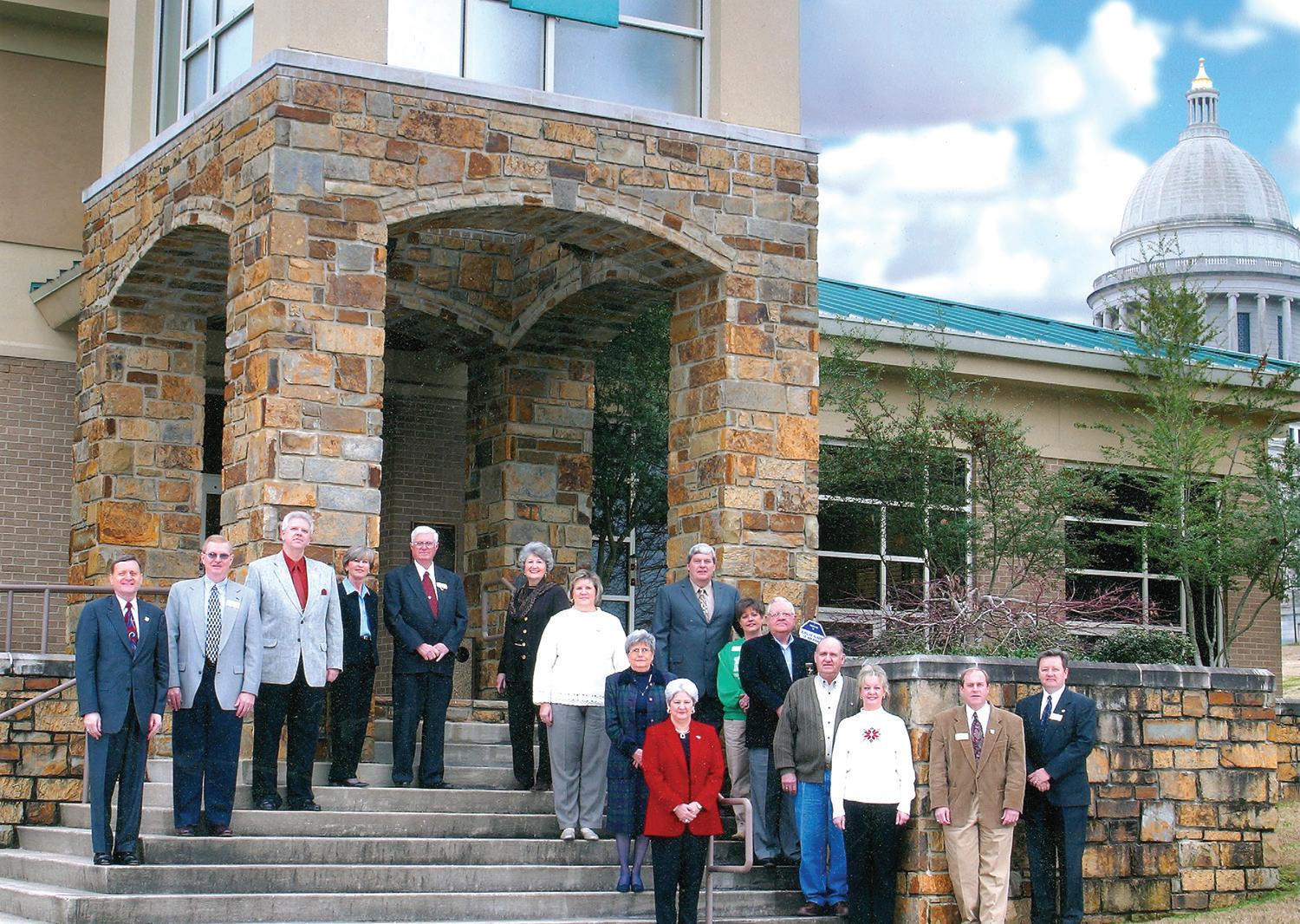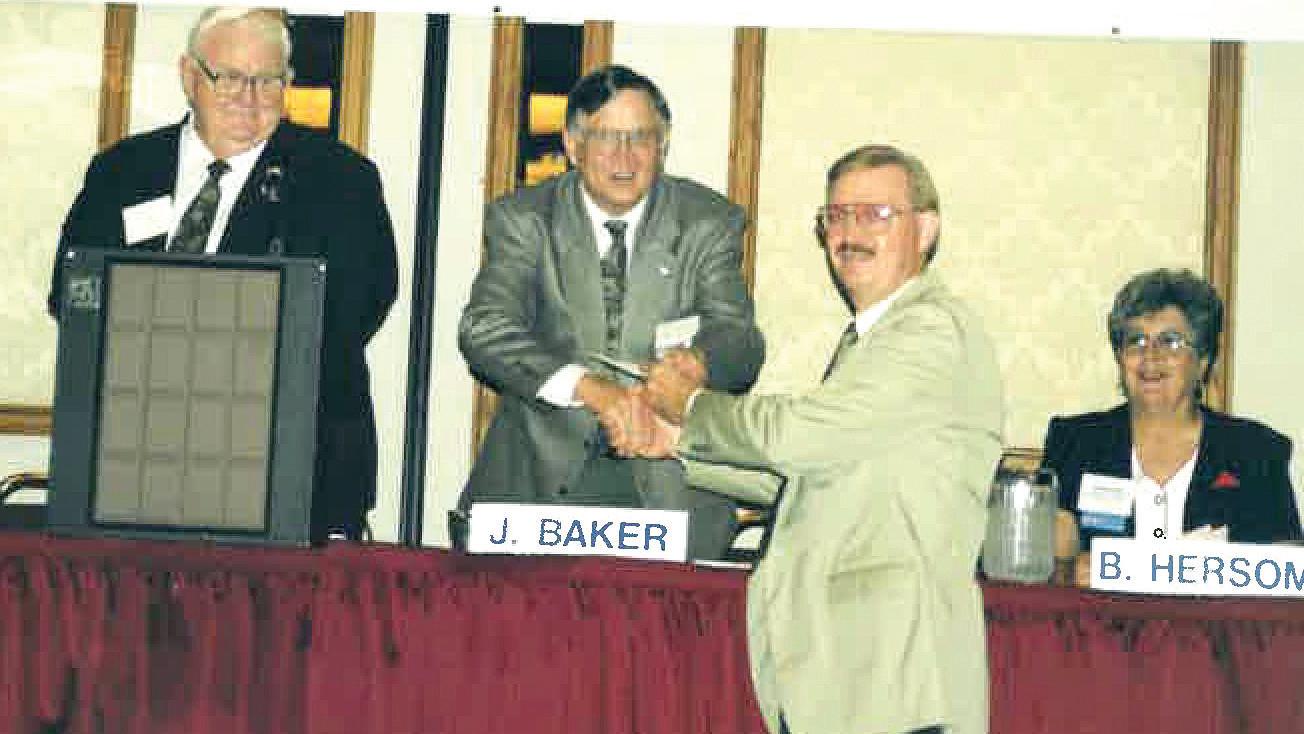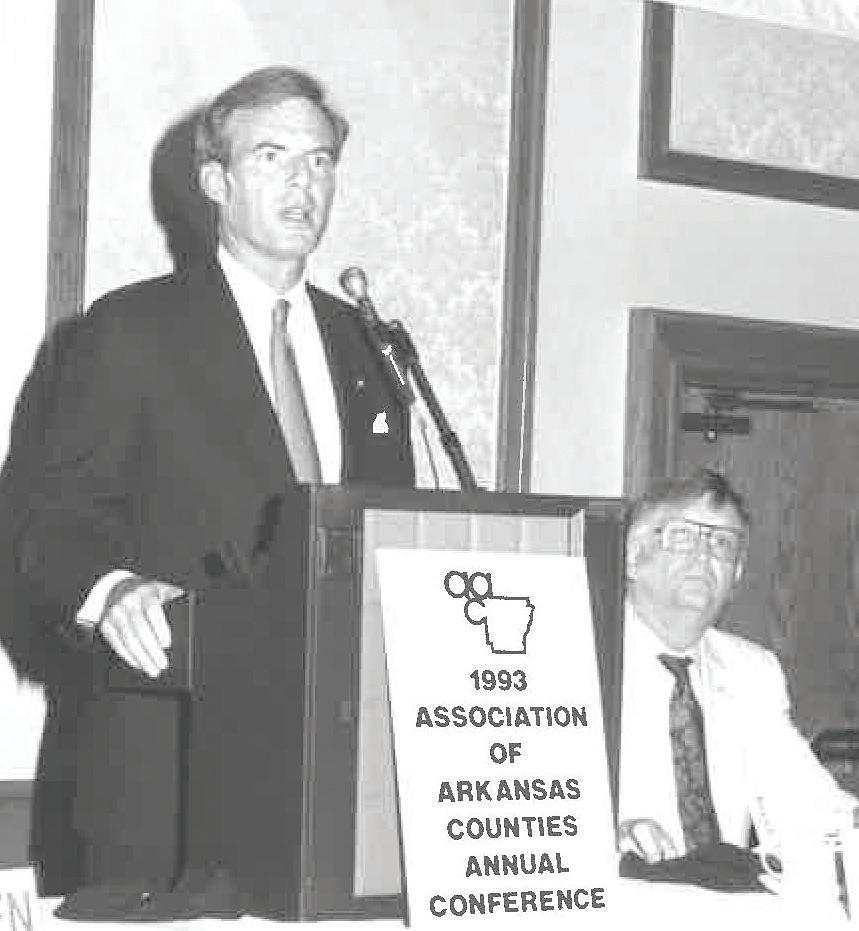
15 minute read
Cover Story: AAC Reflects on 50 Years of Rich History

Above: AAC Board members and county officials break ground in 1996 where the future space was to be added to the AAC building. Top right: Pictured is AAC’s current facility. Right: The late A.A. “Shug” Banks served as Mississippi County Judge for 20 years, was a charter AAC board member, and served as the first AAC board president. Top left: Pictured is the construction of the additional 10,000 square feet that was added to the AAC building. Lower left: Pictured is the building before construction was completed.

AAC reflects on 50 years of rich history of supporting county government
Story by EDDIE A. JONES AAC Consultant
Believe it or not, back in the late 1970’s on the very spot where the west end of the AAC headquarters is located there was an old rundown frame house with a pig pen in the back complete with pigs. Pigs! One block away and within sight of the State Capitol of Arkansas. We’ve come a long way since then. The year 2018 marks our 50th anniversary. We honor our past; celebrate the present; and envision the future.
Founded in 1968, the association has a long track record of achievement, from legislative advocacy to constituent services. Articles of Incorporation for the Association of Arkansas Counties were filed April 10, 1968. But how did AAC get its start?
Let me tell you a bit of that story as told by Jim Pledger and Shug Banks about 25 years ago. Pledger was Yell County treasurer for many years, charter board member of the Association of Arkansas Counties and long-time president of AAC. He served in several capacities in Gov. Bill Clinton’s administration, including director of the department of finance and administration. He later served as director of the Arkansas state fair. Judge Banks served as Mississippi County judge for 20 years (from 1961 to 1980), was a charter board member of the Association of Arkansas Counties and served as the first president of AAC from 1968 through 1980. Judge Banks died in 2001. Mr. Pledger died in 2006.
The idea for the Association of Arkansas Counties was “born on the beaches of Hawaii.” In the mid-60’s a NACo Conference was held in Hawaii. In attendance were Judge A.A. “Shug” Banks of Mississippi County, Yell County Treasurer Jim Pledger and several other Arkansas county officials. It was during this meeting that the idea and the determination to provide the officials of Arkansas with organizational structure was born.
The first attempt to make this idea a reality came during the 1967 legislative session, but it failed. As you might imagine, there was a lot of opposition to the counties becoming organized and establishing an organization that would provide representation for all county officials statewide. Even so, the Association of Arkansas Counties was incorporated by a group of county officials in 1968.
This setback did not deter those county officials such as Judge Banks and Mr. Pledger who were determined to create a representative organization for county government. In 1969 Senate



Top left: AAC board members and county officials take a photo in front of the AAC building as it’s seen today. Above: Jim Baker and county officials rally on the state Capitol steps in support of four-year terms for county officials. Far left: Former U.S. Senator David Pryor speaks at AAC’s 1996 annual conference. Left: Former Arkansas Governor and U.S. President Bill Clinton speaks at an AAC event.
Bill 142 was filed by Sen. John Bearden and Sen. Olen Hendrix that would create the Association of Arkansas Counties legislatively. The legislation passed through the Senate, but was then held up in the House. It appeared that it would come down to a tie vote in the House, and the Speaker would have to vote to determine the outcome of the legislation.
It was also heard that the Speaker’s support for the counties was wavering and that the vote might go against the county officials. A delegation was quickly put together and they paid a visit to the Speaker of the House — Judge Ray Sikes of Little River County and Judge Banks.
The story goes that the Speaker was rumored to be considering a run for the Governor’s office. With this knowledge in hand and being the consummate politician, Judge Sikes reminded the Speaker that “a person who supports you might figure you have the election won and decide to stay home on election day and mow his yard instead of going to the polls to vote. But a person who opposes you will swim a river to vote against you.” Upon contemplating this sage advice, the Speaker wisely voted for the legislation and the rest is history. It became Act 92 of 1969 codified as ACA 14-20-107. AAC became the official voice for Arkansas counties.
The first AAC Annual Conference was in 1972 and was described as “only somewhat successful.” The conference was a one-day affair at the old Lafayette Hotel in Little Rock. Seminars were held during the day, and a banquet was scheduled for that night. Back then, most county officials were not accustomed to over-night meetings in Little Rock so they went home after the seminars.
The banquet was set up to accommodate about 200, but since most officials had already gone home, only 25 showed up. To make matters worse, Congressman Bill Alexander was the keynote speaker and had flown in from Washington specifically for the banquet. It may seem funny now, but it seemed quite a disaster at the time.
This is a marked contrast from our annual conferences of today. It is worth noting that for many years AAC has had 600 to 700 county and district officials in attendance at the annual AAC conferences, which run from Wednesday through Friday. The differences in the quality and attendance during the conferences are not the only differences between the AAC of old and the AAC we all know now.
Most current officials would not recognize the Association of Arkansas Counties in its infancy compared to the 50-year-old organization. AAC now has a nice headquarters and provides many services it did not and could not provide in those early years. In the beginning the association was primarily a lobbyist organization for county government with only three staff persons and a small rented office.
In the beginning, as might be imagined, our lobbying efforts were nowhere near as successful as they are now. It took several years to bring all the county official associations together as a
History

Above: Former AAC Executive Director and retired Randolph County Treasurer Eddie Jones (right, center) shakes the hand of former AAC Executive Director James H. Baker. Former AAC Board President and Craighead County Judge Roy Bearden is pictured at left, and former AAC Board of Directors President Barbara Hersom,both of whom have passed away, sits at right. Right center: Former U.S. Senator from Arkansas and lawyer Blanche Lincoln speaks at an AAC conference. Left: U.S. Senator John Boozman speaks at an AAC conference. Above: Former Arkansas Governor and Lt. Governor Jim Guy Tucker speaks at the 1993 AAC annual conference. Jim Baker sits to his right.
Continued From Page 35 <<<

cohesive group and thinking in terms of solidarity. It also took the Legislature a few years to fully recognize the Association of Arkansas Counties as the agreed upon representative for all of county government statewide. In fact, it took the passage of Amendment 55, landmark legislation that reorganized county government in Arkansas, to change the Association of Arkansas Counties into the organization it is now.
Today, AAC represents 1,332 county and district officials and nine various associations all under one umbrella. After the passage of Amendment 55 in 1974 and the subsequent passage of the enacting legislation, Act 742 of 1977 as amended, county officials were thrust into a new and more complicated system of county government. Quorum courts had new roles and the various constitutional offices were modified to one degree or another. The old fee system of funding officials was abandoned for the current system of paying every county official a salary. It became imperative that county and district officials have a single source they could go to for information on this new and complicated set of laws. The logical provider of this single source of information was, of course, the Association of Arkansas Counties. Starting with Act 742, which was 102 pages of legislation concerning county government, and continuing to this day, the Association of Arkansas Counties strives to provide county and district officials with a single source of quality information. Like state and federal government, county government has grown more complex with volumes of laws that must be adhered to. AAC has worked diligently to keep up with the changing times of county government.
The Association not only lobbies effectively for all county and district officials, but they also get the word out on all new legislation by holding “new legislation seminars.” The AAC office serves as a hub of information on all aspects of county government, from the oldest, most obscure legislation to the newest, most technical legislation to come out of the General Assembly and from the federal level in Washington.
Even though AAC is seen as a lobbying organization, AAC does much more for the county and district officials of Arkansas. They hold various seminars and annual conferences, compile and print training manuals, directories, and other educational material. They publish a quarterly, national awardwinning magazine called County Lines and provide day-to-day consultation for their constituency. AAC also grants academic and financial need scholarships to the children and grandchildren of county and district officials and employees.
The Association of Arkansas Counties provides benefit programs for Arkansas counties. In 1985, AAC added a Workers’ Compensation Trust for counties, and they currently provide workers’ compensation coverage for all 75 counties and several other county entities. In 1986, a Risk Management Fund was established. The Risk Management Fund provides counties with general liability, automobile fleet protection, and a property insurance program. The AAC Risk Management Fund currently provides coverage for 54 counties and about 400 fire departments. Risk Management member counties receive the added benefits of Justice Bridge, a video/audio communications system for use in the courts and sheriff’s offices; Guardian RFID, an inmate tracking system; and codification of county ordinances. The AAC Workers’ Compensation Trust and the Risk Management Fund are completely self-funded and selfadministered and in solid financial condition.

Top left: Conway County Judge Jimmy Hart; the late Jonathan Greer, AAC general legal counsel; and retired Saline County Judge and current Arkansas State Rep. Lanny Fite, attend a meeting. Above center: Former AAC Executive Director Brenda Pruitt sits at the head table during AAC’s 2005 annual conference. Above right: The late Wes Fowler, former AAC covernmental affairs director, Madison County judge and Madison County Clerk, speaks at an association meeting. Bottom left: Former Arkansas Governor Mike Beebe speaks at an AAC annual conference.
Membership in the Association of Arkansas Counties started out slow when the association was first established. But AAC has had 100 percent membership (all 75 counties) every year since 1988. Arkansas has also had 100 percent county membership in NACo since 2007, when the Association of Arkansas Counties started paying the NACo dues for all Arkansas counties. This move has greatly improved Arkansas strength in federal legislative matters.
There has been quite a metamorphosis of AAC facilities and services. The transformation has taken a mere 50 years. AAC originally rented a small office across the street from the State Capitol with three employees. In the late 70’s AAC bought a small piece of property on Victory Street just one block from the Capitol. In 1979, the association completed and moved into its own headquarters — a 3,600-square-foot, multi-level building that served the needs of the county and district officials for many years. The total building and furnishing cost for the original county-owned facility was $220,000. In 1987, the initial investment was paid off.
In 1990, the AAC Board of Directors, under the leadership of then-Executive Director Jim Baker, began to purchase adjoining property — lot by lot. They also started a capital fund for future expansion. In 1996 the Board conducted groundbreaking ceremonies for new construction and remodeling of the old facility. An additional 10,000 square feet of space was added, bringing the Association of Arkansas Counties facility to 13,600 square feet of office and meeting space. Cost for the new addition and remodeling of the old building was $1,579,000 and was completed in March 1997.
Executive Directors Brenda Pruitt and then Eddie Jones continued to set aside money for future expansion of the facility — knowing the time and need would come as AAC continued to broaden its scope of benefits, services, and support for Arkansas’ 75 counties.
In 2013 Executive Director Chris Villines and the board decided the time was right, the need existed, and the money was available to expand the facility. Another 5,200 square feet of office space was added — a two-level, 16-office, two-conference room space on the east end of the complex. And the original 3,600 square foot area was renovated — again! The Risk Management and Workers’ Comp divisions moved into the newest wing of the complex. And the Sheriff’s Association rents office space in the east wing. This addition to the AAC complex, including furnishings, a remodel of the kitchen in the 1997 addition, and repaving the parking lots cost about $1,750,000 — all paid for with moneys saved specifically for expansion. No debt! And this 18,800-square-foot facility belongs to the counties of Arkansas.
One of the greatest assets of AAC is the fact that our office complex is only a block from the State Capitol where most of the lobbying efforts are centered. Our close proximity to the Capitol is the envy of county associations across America.
Over a 50-year period the Association of Arkansas Counties has grown from a small rented office with three employees to a county owned 18,800-square-foot complex with 31 employees serving county government in multiple ways.
The Association of Arkansas Counties is an organization of solidarity, the umbrella organization for nine affiliate associations — County Judges, County Clerks, Assessors, Collectors,
History
Continued From Page 37 <<<


Above: AAC Executive Director Chris Villines, NACo Past President Sally Clark, Arkansas Governor Asa Hutchinson, former AAC Board of Directors President and Clark County Treasurer Judy Beth Hutcherson, and Sebastian County Sheriff Bill Hollenbeck pose for a photo. Top right: Villines, Former AAC Board President and retired Johnson County Judge Mike Jacobs, and Pulaski County Sheriff Doc Holladay talk during AAC’s conference. Right: Conference attendees participate in AAC’s annual conference roll call.

Treasurers, Circuit Clerks/Recorders, Sheriffs, Coroners; and Justices of the Peace making up the 75 county Quorum Courts. Each of the affiliate organizations has two board members on the AAC Board of Directors, comprising an 18-member board.
In addition to the solidarity of AAC’s affiliate associations - our strength and stability comes from continuity of leadership. The Association has had only nine (9) Presidents of the Board and six (6) Executive Directors in our 50-year history.
Other reasons for the growth and success of the Association of Arkansas Counties can be attributed to:
• Mission — AAC has had an inspiring shared mission at our core; • Vision — AAC has had an idea of where we were going. A vision abstract enough to encourage people to imagine it but concrete enough for members to see it; • Competency — AAC has had competent leaders. You must be seen by the stakeholders, employees and legislative leaders as being an expert in the field of county government or an expert in leadership; • A strong team — AAC has had strong teams through the years. Realistically, few executives possess all of the skills and abilities necessary for total mastery of every area within the organization. To complement the areas of weakness, a wise leader assembles effective teams of experienced, credentialed, and capable individuals who can supplement any voids in the leader’s skill set; • Communication skills — AAC has had some good communicators at the helm. It does little good to have a strong mission, vision, and goals — and even a solid budget — if the executive cannot easily and effectively convey his ideas to the stakeholders inside and outside the organization;
• A “can do, get it done” attitude — AAC has a record of getting it done. Nothing builds a picture of success more than achievement, and achievement is the No. 1 factor that motivates just about everyone. • Inspiration — AAC has had some inspirational leaders, both as director and board members and officers. Employees and constituents of an organization need someone to look up to for direction, guidance, and motivation; and • Ambition — AAC has always been moving forward. Resting on your laurels is bad for morale and credibility. Employees and constituents need to see an organization constantly striving for improvement and success. That comes first and foremost from the leader.
We have looked back to view the 50-year history of the Association of Arkansas Counties, and it’s easy to see that progress has been made — and lots of it. But most importantly we should look forward! Look toward the next 50 years and visualize the progress that will be made for county government in Arkansas. I have witnessed, first hand, the past 38 years of county government — and what a change I have witnessed. I have hope for positive change because now, as in the past, we have some great leaders in county government — leaders that will move us into new and better ways of serving, leaders that will prepare the next generation of leaders by instilling in them the conviction and the will to carry on.
As Loretta Lynn’s 1979 country song said, “We’ve come a long way, Baby!” Since the founding and incorporation of the Association of Arkansas Counties in 1968 we have a rich 50year track record of great achievement. So, “We Honor our Past, We Celebrate the Present, and We Envision our Future.” The Association of Arkansas Counties — 75 counties, One voice!










